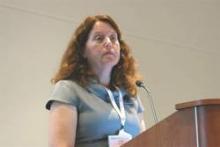WASHINGTON – Sustained virologic response rates for genotype 1 and 2 patients are lower with sofosbuvir-based hepatitis C virus regimens in routine clinical practice than clinical trials, results from a large observational cohort analysis showed.
Patients with advanced liver disease and those with detectable HCV RNA at 4 weeks were significantly less likely to achieve a sustained virologic response (SVR), study author Dr. Lisa Backus reported at the annual Digestive Disease Week.
SVR rates with sofosbuvir (Sovaldi), which was approved in late 2013 for the treatment of HCV, have been reported in clinical trials generally in the 90%-plus range in genotype 1 (GT1) and 2 (GT2) patients.
“Often, however, it’s apparent that there are differences between the outcomes in clinical trials and routine medical practice,” said Dr. Backus of the VA Palo Alto (Calif.) Health Care System.
As a result, the investigators assessed clinical data from electronic medical records for 4,026 patients with GT1 or GT2 HCV who started sofosbuvir-based therapy for the recommended 12-week duration through the U.S. Department of Veterans Affairs, the largest integrated national provider of HCV care. Roughly a third of the patients were treatment experienced, and their average age was 61 years.
Among 3,203 GT1 patients, 1,302 started sofosbuvir, peginterferon, and ribavirin (SOF+PEG+RBV); 1,559, sofosbuvir plus simeprevir (SOF+SIM; Olysio); and 342, SOF+SIM+RBV. All 823 GT2 patients started SOF+RBV. About 10%-14% of patients did not receive 84 days of drug.
Patients were considered to have no SVR if HCV RNA was detectable on any test after the end of treatment, if they had no test after the end of treatment and HCV RNA was detectable on their last on-treatment test, or if they died before 12 weeks after the end of treatment. In all, 2,417 GT1 patients and 619 GT2 patients had SVR results.
Overall SVR rates were 66.8% with SOF+PEG+RBV, 75.3% with SOF+SIM, and 74.1% with SOF+SIM+RBV in GT1 patients and 79% with SOF+RBV in GT2 patients, Dr. Backus said.
For GT1 patients, SVR rates for treatment-naive vs. treatment-experienced patients were significantly different with SOF+PEG+RBV (73.7% vs. 55.6%; P <.001), but not with SOF+SIM (77.8% vs. 71.2%) or SOF+SIM+RBV (74.7% vs. 73.3%).
SVR rates were also different with SOF+RBV for GT2 treatment-naive vs. treatment-experienced patients (81.6% vs. 70.9%; P <.01), she reported.
Baseline factors associated with significantly lower SVR rates varied in GT1 treatment-naive and treatment-experienced patients by regimen, although an aspartate aminotransferase-to-platelet ratio index (APRI) score >2 was a significant predictor in treatment-naive patients for all three regimens and in treatment-experienced patients on SOF+PEG+RBV or SOF+SIM.
In a multivariate analysis adjusted for age, sex, race, body mass index (BMI), decompensated liver disease, diabetes, treatment experience, APRI score, HCV subtype, and regimen, GT1 patients with a BMI of at least 30 kg/m² had significantly lower odds of achieving a sustained virologic response (odds ratio, 0.64), as did those with decompensated liver disease (OR, 0.51), prior treatment experience (OR, 0.58), or an APRI score >2 (OR, 0.44), or those receiving SOF+PEG+RBV, compared with SOF-SIM (OR, 0.50; P values for all <.001), Dr. Backus said. The odds of achieving a sustained virologic response with SOF+SIM+RBV did not differ from the odds of doing so with SOF+SIM (OR, 1.03; P = .86).
Adding 4-week HCV RNA levels to the model did not change most baseline predictors, but showed that the odds of an SVR were reduced 41% for patients with 4-week HCV RNA <43 IU/mL (OR, 0.59; P <.001) and 58% for those with 4-week HCV RNA ≥43 IU/mL (OR, 0.42; P <.001), compared with patients with undetectable levels.
In GT2 patients, significant baseline predictors of lower SVR rates were an APRI >2 and a fibrosis-4 (FIB-4) index >3.25 in treatment-naive patients and a FIB-4 >3.25 in treatment-experienced patients.
Using the first multivariate model, treatment experience (OR, 0.55; P <.01) and an APRI >2 (OR, 0.39; P <.001) predicted markedly lower odds of a sustained virologic response. Both factors remained significant in the second multivariate model, along with 4-week HCV RNA <43 IU/mL (OR, 0.29; P <.001) and ≥43 IU/mL (OR, 0.21; P <.001), Dr. Backus reported.
Study limitations were the lack of treatment randomization, testing and follow-up at the discretion of the provider, the use of surrogate laboratory markers (APRI or FIB-4) since few patients had biopsy or fibroscan results, and the lack of data on Q80K polymorphism status, she said.
Attendees questioned whether compliance could have caused such vastly lower SVR rates than reported in other trial settings. Dr. Backus acknowledged that she and her* colleagues did not do chart reviews of actual discontinuation rates, but argued that adherence rates of 70%-80% in regular clinical practice in other fields of medicine, such as infectious diseases, are considered incredibly high.

